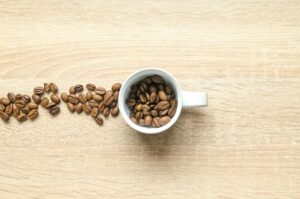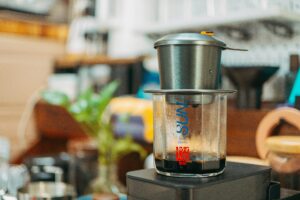Ah, the magic of coffee. That invigorating aroma, the warmth cupped in your hands, and the satisfying flavor that jumpstarts your day. But when brewing a pot for a crowd, the question arises: how much coffee do I actually need to achieve that perfect cup, without venturing into bitter oblivion? Fear not, fellow coffee enthusiast, for we’re here to navigate the wonderful world of coffee-to-water ratios and unveil the secrets to an exceptional eight-cup brew!
Table of contents
Understanding the Grind: A Course Correction
Before diving into measurements, let’s address a bean-tastic factor: the grind. Imagine coarse grinds as chunky pebbles and fine grinds as powdery sand. The size of your grind particles significantly affects how quickly water extracts flavor and caffeine. A coarse grind is ideal for full-immersion brewing methods like French presses, while finer grinds are better suited for drip coffee makers where water has less contact time. Using the wrong grind size can lead to weak or overly bitter coffee, so matching your grind to your brewing method is crucial.
The Golden Ratio: A Balancing Act for the Perfect Cup
Now, let’s talk specifics! The coffee industry often references a “golden ratio” – a starting point for achieving a balanced cup. This ratio suggests using 1-2 tablespoons of ground coffee per 6 ounces of water. So, for an 8-cup pot (which typically translates to 48 ounces of water), you’d be looking at:
- For a mild cup: 8 tablespoons (1/2 cup) of ground coffee
- For a medium-strength cup (the happy medium): 12 tablespoons (3/4 cup) of ground coffee
- For a strong cup: 16 tablespoons (1 cup) of ground coffee
Beyond the Ratio: Tailoring Your Coffee Adventure
The beauty of coffee is its adaptability. The golden ratio provides a foundation, but feel free to experiment to discover your perfect cup. Here are some factors to consider when adjusting the coffee grounds:
- Coffee Strength Preference: Do you crave a bold and robust cup, or a more subtle and delicate flavor? Adjust the amount of coffee grounds accordingly.
- Coffee Bean Type: Different beans have varying strengths. Robusta beans naturally have more caffeine than Arabica beans. Consider the inherent intensity of your chosen beans when measuring.
- Freshness is Key: Freshly roasted coffee beans boast the most vibrant flavors and aromas. Older grounds can lead to a weak or stale-tasting brew.
Fellow Stagg EKG Electric Gooseneck Kettle

- STAGG EKG ELECTRIC KETTLE
- PRECISION POUR
- TEMPERATURE MATTERS
- BREW LIKE A PRO: A sleek LCD
- PREMIUM MATERIALS
Beyond Scoops: The Art of Weighing for Precision
While tablespoons are a common measurement, using a scale for coffee grounds can elevate your brewing game. Think of it like following a recipe – precise measurements ensure consistent results. Coffee grounds can vary in density depending on the roast and grind size. A scale ensures you’re using the exact weight of coffee for optimal extraction. Here’s a handy conversion guide:
- 1 tablespoon of ground coffee = approximately 5-8 grams (depending on grind size)
Brewing Techniques: Tailoring Measurements for Different Methods
The recommended coffee-to-water ratio might differ slightly depending on your brewing method. Here’s a quick reference for some popular techniques:
- French Press: A slightly lower ratio (around 1:15 coffee to water) can be a good starting point due to the longer immersion time.
- Pour-Over: A 1:16 or 1:17 ratio works well for pour-over methods, which allow for more precise control over water flow.
- Drip Coffee Maker: The standard 1:16 or 1:18 ratio is a good starting point for most drip coffee makers.
The Final Sip: Experimentation is Your Friend
Remember, these are just guidelines! Don’t be afraid to experiment and find your personal coffee nirvana. The best way to discover your perfect cup is to brew, taste, and adjust. Keep track of your coffee-to-water ratio, grind size, and brewing time to create a personalized recipe for a consistently delicious cup.
Additional Coffee Brewing Tips
- Use filtered water: Water quality significantly impacts coffee taste. Avoid using tap water with a strong mineral content.
- Preheat your coffee maker: A hot carafe ensures your coffee stays warm without burning.
- Store coffee beans properly: Keep them in an airtight container away from light and heat to preserve freshness.
- Clean your coffee maker regularly: Mineral buildup can affect taste and brewing performance.
From Measuring Spoons to Brewing Bliss
With a little knowledge and experimentation, you can transform your coffee routine from a daily ritual to a sensory adventure. By understanding the impact of grind size, coffee-to-water ratios, and brewing techniques, you can unlock a world of flavor profiles and brewing methods. Remember, there’s no single “correct” way to brew coffee. It’s a journey of exploration, discovery, and ultimately, a delicious cup that perfectly reflects your taste preferences.
Coffee Math Made Easy!
Need a quick way to calculate the amount of coffee grounds for your desired strength? Here’s a simple formula:
- Coffee grounds (in tablespoons) = Desired Strength (in tablespoons per cup) x Number of cups x 2
For example, if you want a medium-strength 8-cup pot (12 tablespoons per cup), you’d use:
- Coffee grounds = 12 tablespoons/cup x 8 cups x 2 = 192 tablespoons
Divide this number by 16 (the number of tablespoons in a cup) to get the final amount in cups:
- Coffee grounds = 192 tablespoons / 16 tablespoons/cup = 12 cups
Remember, this is just a starting point! Adjust the final amount based on your preferred strength and brewing method.
The Final Cup: A Celebration of Coffee’s Versatility
Coffee is more than just a morning pick-me-up. It’s a ritual, a social lubricant, and a source of creative inspiration. Whether you’re a seasoned coffee connoisseur or a curious newcomer, there’s a brewing method and flavor profile waiting to be discovered. So, grab your favorite mug, experiment with different coffee-to-water ratios and brewing techniques, and embark on your own personal coffee journey. With a little knowledge and a dash of experimentation, you’ll be brewing barista-worthy cups in no time, ready to savor the magic of coffee in every sip. Now go forth, brew boldly, and enjoy the delicious adventure!






